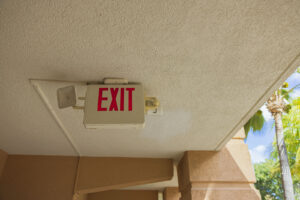Blog
- Home
- Resources
- Bright Ideas Blog
- Emergency Lights – Should I Change the Battery or Change the Entire Fixture?
Emergency Lights – Should I Change the Battery or Change the Entire Fixture?

Emergency lights typically have a battery back-up that will operate the light in the event the power goes out, regardless of if there’s a generator for back-up power. Exit signs can and should also have a battery, especially if the building doesn’t have generator.
Often during fire department inspections, they check that your emergency lights are operational, both with and without power. Emergency lights must be kept properly maintained to meet all federal and state requirements, so when installing new ones or updating old ones, should you just change the battery or replace the entire fixture?
Requirements For Emergency Lights
Emergency lights are required to illuminate areas when something goes wrong, such as a fire. Commercial buildings must have emergency and exit-path lighting to illuminate and identify hallways, stairwells, and exits. Lighting must emit at least 1.07 lux of light along the emergency exit path at floor level and must remain illuminated for at least 90 minutes.
Even if a building does not have a centralized inverter or backup generator, emergency lighting must still be distributed. This requires dedicated emergency lights or battery backup LED drivers in certain fixtures. In many cases, lights that are required to be battery powered will use different circuitry in the event of a power outage.
When To Replace Batteries In Emergency Lights
There are two main types of batteries used to power exit signs and emergency lights:
- Nickel-cadmium batteries
- Smaller in size.
- Turn in any direction.
- Lighter weight, requiring less installation support.
- Can cost more.
- Are affected by extreme temperatures.
- If battery is not fully charged in beginning, it will never be fully charged.
- Lead-acid batteries
- Most affordable.
- Less affected by extreme temperatures.
- Heavier, requiring additional support when installing.
- Must be upright.
- Larger in size.
- Cannot be deep cycled.
Battery life typically ranges between 2-4 years, they are available in different voltages and amperages, and maintenance is relatively quick and simple. Batteries for emergency lighting must be regularly cleaned and tested to ensure they are still operational and the lighting is not dimmed. A fully charged battery in good condition should power an emergency light for at least 90 minutes. You must replace the battery if the 90-second or 90-minute emergency readiness tests prove unsatisfactory (meaning the lights fail to illuminate or are not bright enough).
Note that each battery must be tested separately on a regular basis and replaced as soon as possible if necessary.
Even if a battery is still functional after the maximum operational lifespan (typically four years), it’s a good idea to replace it. For organization purposes, it’s much easier to replace all batteries at once rather than one here, one there. If the building is very large, perhaps your system might call for replacing batteries by floor, as an example. Also replace if they are showing any wear and tear, though some battery damage can damage the entire fixture and require a full replacement.
When To Replace Emergency Light Fixture
There are a number of reasons you may want or need to replace your emergency light fixture.
Illumination technology has changed drastically over the last decade, including wide-spread adoption of LED lighting technology that:
- Uses less energy.
- Is more efficient.
- Allows for smaller, safer lighting products.
- Can maintain minimum 90-minute illumination period regulated for all emergency lights without using an additional battery pack.
Lights themselves are also smaller now in comparison to traditional incandescent and halogen bulbs, producing less heat. There are new, sleeker designs to choose from, which may be an attractive option for commercial or apartment buildings.
If an emergency light contains traditional halogen or incandescent lightbulbs, it’s much larger than others on the market and it’s likely at least 10 years old, so consider replacing it with an LED light.
Obvious signs of wear and tear (dirty, discolored, hazy lamp heads, film) can all impact light performance. If the fixture shows these signs, consider replacing it. Additionally, if a fixture’s battery is showing signs of corrosion, is leaking, is foamy, or is crusty, this is a clear sign of age and it should be replaced.
Why Would I Just Change the Battery?
One might ask, why would anyone change the battery and not just get a new fixture? With LED lighting technology improving, prices aren’t what they used to be, so why not spend a little bit more and get a new fixture versus putting in a new battery?
- Changing a battery is often much easier than changing a fixture. Your property might have several employees that are skilled enough to replace hundreds of batteries, but you might not have someone on staff that is able to replace an entire light fixture where wiring is involved. Typically, a licensed electrician is best suited for this task, which can be more costly and take more time.
- When changing an entire fixture, an electrician will most likely want to turn off the power in the area where they are working. Turning off the power when people are in the building and working takes a lot of coordination, and you will likely have a few tenants that aren’t happy. Typically, changing batteries does not require the power to be shut off.
- As mentioned, batteries don’t always function properly in cold weather or if they get wet. In this instance, an electrician might choose to have an inside fixture’s battery, power and remote head outside, for example. While it’s not an issue, this is something that needs to be taken into consideration so nothing gets missed.
Ready To Upgrade Your Emergency Lighting?
Bay Lighting has more than 70 years of combined lighting and electrical experience. Our experienced technicians can help you install new emergency lights at your commercial building or residential property. Contact Bay Lighting today to schedule a free estimate and learn more about upgrading your facility’s emergency lighting systems.




